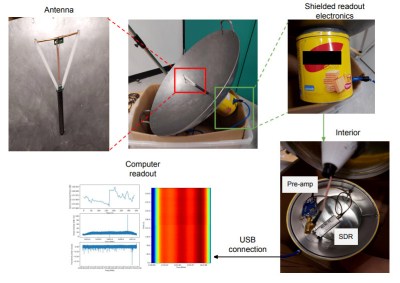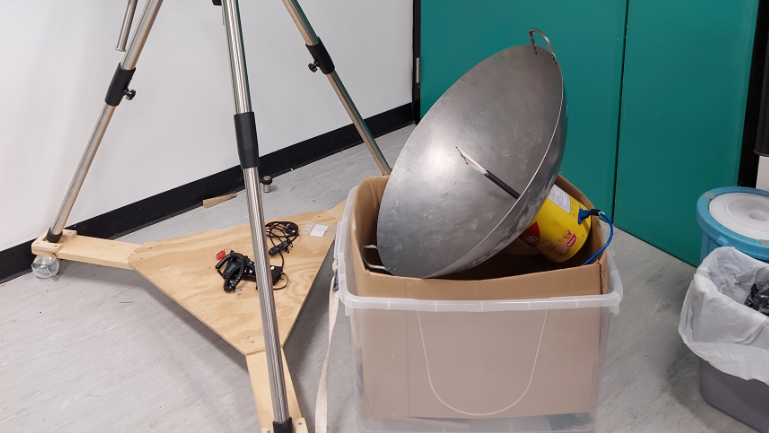The round bottom of a proper wok is the key to a decent stir fry, but it also makes it hard to use on traditional Western stoves. That’s why many woks end up in a dark kitchen cabinet, unused and unloved. But wait; it turns out that the round bottom of a wok is the perfect shape for gathering something else — radio waves, specifically the 21-cm neutral hydrogen emissions coming from the heart of our galaxy.
Turning a wok into an entry-level radio telescope doesn’t appear to be all that hard, at least judging by what [Leo W.H. Fung] et al detail in their paper (PDF) on “WTH” or “Wok the Hydrogen.” Aside from the wok, which serves as the main reflector, you’ll need a bit of coaxial cable and some stiff copper wire to fashion a small dipole antenna and balun, plus some plastic tubing to support it at the focal point of the reflector. Measuring the wok’s shape and size, which in turn determines its focal point, is probably the hardest part of the build; luckily, the paper includes tips on doing just that. The authors address the controversy of parabolic versus spherical reflectors and arrive at the conclusion that for a radio telescope fashioned from a wok, it just doesn’t matter.
 As for the signal processing chain, WTH holds few surprises. A Nooelec Sawbird+ H1 acts as preamp and filter for the 1420-MHz hydrogen line signal, which feeds into an RTL-SDR dongle. Careful attention is paid to proper grounding and shielding to keep the noise floor as low as possible. Mounting the antenna is a decidedly ad hoc affair, and aiming is as simple as eyeballing various stars near the center of the galactic plane — no need to complicate things.
As for the signal processing chain, WTH holds few surprises. A Nooelec Sawbird+ H1 acts as preamp and filter for the 1420-MHz hydrogen line signal, which feeds into an RTL-SDR dongle. Careful attention is paid to proper grounding and shielding to keep the noise floor as low as possible. Mounting the antenna is a decidedly ad hoc affair, and aiming is as simple as eyeballing various stars near the center of the galactic plane — no need to complicate things.
Performance is pretty good: WTH measured the recession velocity of neutral hydrogen to within 20 km/s, which isn’t bad for something cobbled together from scrap. We’ve seen plenty of DIY hydrogen line observatories before, but WTH probably wins the “get on the air tonight” award.
Thanks to [Heinz-Bernd Eggenstein] for the tip.















Two words “Spherical aberration”
Once a focal point is selected it will be perfect for looking at one frequency, but higher frequencies will have a different focal point than lower frequencies with a spherical dish.
Right. This particular device is looking at a single frequency so there’s no problem. The Doppler shift they are looking at is on the order of 200kHz, so there shouldn’t be a noticeable problem with the focal point.
Spherical aberration is what it’s called when rays from the edges and rays from the center meet at different distances along the axis. That’s still true for rays at the same wavelength/frequency/color. It’s minimized by using very long focal lengths, which at the same diameter are a flatter piece of a very large sphere and are also necessarily more “stopped down” for the same actual diameter. It’s properly dealt with by using optics which aren’t spherical, of course.
Focusing different frequencies at different distances is something you see with refractive optics rather than reflective, and in optics it’s chromatic aberration. Regular mirrors don’t reflect different colors at significantly different angles. Are you saying this one does?
In the paper they say it was neither spherical nor parabolic, but that the focal point ended up somewhat in between and (paraphrasing) it was good enough to approximate it as being similar to both. Admittedly, since it’s a dipole driving it, the pattern isn’t going to be static with changing frequency anyway. But the reflector doesn’t seem that bad, all things considered. Might have rathered not to be iron since it throws things off a bit, but the results were pretty good for the price.
If an iron wok is close, but not QUITE accurate enough, you can of course perform a concussive calibration.
So you make the dipole in the middle adjustable or swappable.
Or you go tear off that satellite TV dish on your roof that hasn’t been used since 2008.
You really don’t know anything about spherical aberration, do you? Has NOTHING to do with changes in frequency. The biggest concern I have with the wok, is that it is too small for it to be weffective given that the wavelength is 21 cm. Diffraction is your “enemy” here, geometrical optics is almost irrelevant
Since it’s not trying to image anything, it just has to be good enough to produce a signal strong enough to be detected over the noise. Nothing about this is idea, but going to a perfect parabola and a proper feed wouldn’t change the result
Looks like in interesting, Saturday project for my boy and me to make, he loves space so listening to it might be cool for him.
“The round bottom of a proper wok is the key to a decent stir fry, but it also makes it hard to use on traditional Western stoves.”
Flat-bottom is better.
https://inquiringchef.com/how-to-cook-with-a-wok/
“How to wok your dog!” 🐕
Time to make the jamaican version out of steel pan/-drums. I can hear the melody from arielle the little mermaid. :-D
Similar idea to our Discovery Dish!
https://www.crowdsupply.com/krakenrf/discovery-dish
Here’s Another Idea : Build a 1m Photo Umbrella Radio Telescope video includes examples of data acquired = It Works .. https://www.youtube.com/watch?v=ymclkNnCeCc
Round-bottom woks, if magnetic, work fine on flat induction hobs. I now have a concave hob specifically designed for woks, but I got by for years using a flat surface. You might think the energy transfer would be very inefficient, but my wok would get so screaming hot that I’d have to turn down the power on the hob.
Here’s a project idea for the Hackaday types: How about a method for visualizing, in 3D, magnetic fields like the ones around induction hobs? It would be so, so groovy to be able to watch the cooking vessel interact with the energy source!!